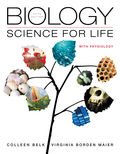
Concept explainers
To describe:
The value of placebo in experimental design.
Introduction:
The placebo can be defined as the substance, which do not have a specific inherent value or medicinal value. In an experiment the placebo is provided to the control group and the experimental group to maintain a general condition for both.
Explanation of Solution
During any experiment, the placebo is used as a substance, which have 0 value of the experimental variable. The placebo helps in maintaining the similar condition for the experimental and the control group. This way, the placebo allows to minimize the effect of other variables, such as temperature, pressure, etc.
The placebo allows treatment of the control group similar to the experimental group except for the independent variable being tested in the experimental group. Hence, it reduces the effect of other variables, which are not required to be tested.
Want to see more full solutions like this?
Chapter 1 Solutions
EBK BIOLOGY
- What is behavioral adaptarrow_forward22. Which of the following mutant proteins is expected to have a dominant negative effect when over- expressed in normal cells? a. mutant PI3-kinase that lacks the SH2 domain but retains the kinase function b. mutant Grb2 protein that cannot bind to RTK c. mutant RTK that lacks the extracellular domain d. mutant PDK that has the PH domain but lost the kinase function e. all of the abovearrow_forwardWhat is the label ?arrow_forward
- Can you described the image? Can you explain the question as well their answer and how to get to an answer to an problem like this?arrow_forwardglg 112 mid unit assignment Identifying melting processesarrow_forwardGive only the mode of inheritance consistent with all three pedigrees and only two reasons that support this, nothing more, (it shouldn't take too long)arrow_forward
- Oarrow_forwardDescribe the principle of homeostasis.arrow_forwardExplain how the hormones of the glands listed below travel around the body to target organs and tissues : Pituitary gland Hypothalamus Thyroid Parathyroid Adrenal Pineal Pancreas(islets of langerhans) Gonads (testes and ovaries) Placentaarrow_forward
 Principles Of Radiographic Imaging: An Art And A ...Health & NutritionISBN:9781337711067Author:Richard R. Carlton, Arlene M. Adler, Vesna BalacPublisher:Cengage LearningCase Studies In Health Information ManagementBiologyISBN:9781337676908Author:SCHNERINGPublisher:Cengage
Principles Of Radiographic Imaging: An Art And A ...Health & NutritionISBN:9781337711067Author:Richard R. Carlton, Arlene M. Adler, Vesna BalacPublisher:Cengage LearningCase Studies In Health Information ManagementBiologyISBN:9781337676908Author:SCHNERINGPublisher:Cengage





